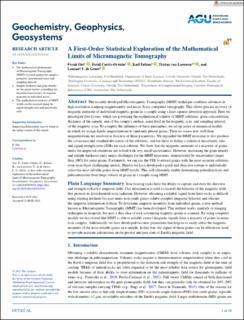| dc.contributor.author | Out, Frenk | |
| dc.contributor.author | Cortés-Ortuño, David | |
| dc.contributor.author | Fabian, Karl | |
| dc.contributor.author | van Leeuwen, Tristan | |
| dc.contributor.author | de Groot, Lennart V. | |
| dc.date.accessioned | 2023-09-13T09:22:43Z | |
| dc.date.available | 2023-09-13T09:22:43Z | |
| dc.date.created | 2022-06-09T16:06:05Z | |
| dc.date.issued | 2022 | |
| dc.identifier.citation | Geochemistry Geophysics Geosystems. 2022, 23 (4), 1-18. | en_US |
| dc.identifier.issn | 1525-2027 | |
| dc.identifier.uri | https://hdl.handle.net/11250/3089096 | |
| dc.description.abstract | The recently developed Micromagnetic Tomography (MMT) technique combines advances in high resolution scanning magnetometry and micro X-ray computed tomography. This allows precise recovery of magnetic moments of individual magnetic grains in a sample using a least squares inversion approach. Here we investigate five factors, which are governing the mathematical validity of MMT solutions: grain concentration, thickness of the sample, size of the sample's surface, noise level in the magnetic scan, and sampling interval of the magnetic scan. To compute the influence of these parameters, we set up series of numerical models in which we assign dipole magnetizations to randomly placed grains. Then we assess how well their magnetizations are resolved as function of these parameters. We expanded the MMT inversion to also produce the covariance and standard deviations of the solutions, and use these to define a statistical uncertainty ratio and signal strength ratio (SSR) for each solution. We show that the magnetic moments of a majority of grains under the inspected conditions are solved with very small uncertainties. However, increasing the grain density and sample thickness carry major challenges for the MMT inversions, demonstrated by uncertainties larger than 100% for some grains. Fortunately, we can use the SSR to extract grains with the most accurate solutions, even from these challenging models. Hereby we have developed a quick and objective routine to individually select the most reliable grains from MMT results. This will ultimately enable determining paleodirections and paleointensities from large subsets of grains in a sample using MMT. | en_US |
| dc.language.iso | eng | en_US |
| dc.publisher | American Geophysical Union | en_US |
| dc.rights | Navngivelse-Ikkekommersiell 4.0 Internasjonal | * |
| dc.rights.uri | http://creativecommons.org/licenses/by-nc/4.0/deed.no | * |
| dc.title | A First-Order Statistical Exploration of the Mathematical Limits of Micromagnetic Tomography | en_US |
| dc.title.alternative | A First-Order Statistical Exploration of the Mathematical Limits of Micromagnetic Tomography | en_US |
| dc.type | Peer reviewed | en_US |
| dc.type | Journal article | en_US |
| dc.description.version | publishedVersion | en_US |
| dc.source.pagenumber | 1-18 | en_US |
| dc.source.volume | 23 | en_US |
| dc.source.journal | Geochemistry Geophysics Geosystems | en_US |
| dc.source.issue | 4 | en_US |
| dc.identifier.doi | 10.1029/2021GC010184 | |
| dc.identifier.cristin | 2030561 | |
| cristin.ispublished | true | |
| cristin.fulltext | original | |
| cristin.qualitycode | 1 | |

